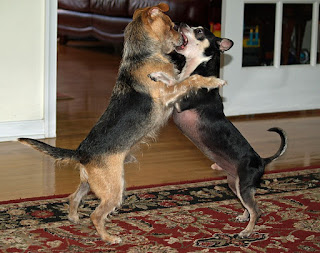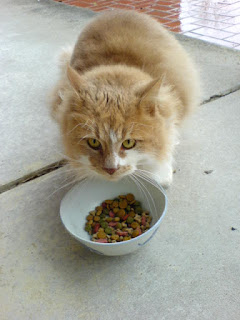The
Pet Travel Scheme ("PETS") is a system which allows animals to travel
easily between member countries without undergoing quarantine. A Pet Passport
is a document that officially records information related to a specific animal,
as part of that procedure. The effect is to drastically speed up and simplify
travel with and transport of animals between member countries, compared to
previous procedures, if the regulations are followed.
PETS
was originally introduced for the benefit of animals entering or returning to
the United Kingdom from other European Union countries, since historically the
UK had very strong controls to safeguard against rabies including a compulsory
six-month quarantine period on imports of many animals. On 1 October 2001
several European Union countries introduced the PETS scheme, under which
animals from any member country may freely travel (with the correct procedure)
to any other member country on approved carriers. Over time the scheme has
rolled out to other countries such as the United States, Canada, Australia and
New Zealand
Appearance
The
pet passport itself comes in multiple forms, sometimes a pink A4 sheet,
sometimes a small blue booklet. It contains the microchip or tattoo number of
the animal, the certification that it has had a rabies vaccination, and needs
to be signed by an officially approved veterinary surgeon.
A
new style passport with laminated strips and additional security measures was
introduced in the UK in December 2014. Old style passports remain valid.
The
passport is not to be confused with a much smaller folder (sometimes purple
coloured), routinely issued by vets, which records the complete vaccination
history of the pet.
Details of procedure
Every
country has different requirements, both for export and import of animals,
although some features are common to all.
Common features
All
countries:
Subcutaneous
(below the skin) microchip implant that meets the International Society of
Pharmacovigilance (SoP) specification.
Certified
rabies vaccination, with some kind of prior period of time or evidence the
vaccination is working (commonly blood serology tests to confirm the
vaccination has "taken" and a delay of some months to confirm the
animal is rabies-free initially). For pet travel in Europe, the rabies vaccine
should be administered by a veterinarian with a minimum of 21 days (taken from
UK Gov website 04 Feb 2014) before travel. Some countries may differ and always
check with your local veterinarian for the procedures to follow.
Some
countries:
·
Animal treated for ticks, fleas and tapeworms
between 24 and 48 hours before boarding the outbound transport. The time limit
is usually enforced strictly (i.e. no less than 24 hours and no more than 48
hours before check-in)
·
Veterinarian's letter or certificate confirming
fitness to travel and/or no obvious signs of disease
·
Government certification that the veterinarian's
export documentation and certificates are in order for travel
·
Sometimes only certain carriers or certain
import/export points will allow animals.
In
some countries the formal passport is needed. Others will accept documentation
in any form so long as it is clearly evidential of the procedure being
followed. Usually the animal and its papers are checked thoroughly both on
boarding or export and upon arrival.
The
Pet Passport alone can be used to enter some countries if it records all
relevant information (e.g. the UK), but it will not suffice to enter many
countries. For instance Guatemala, in common with almost every country
operating such a scheme, demands that all imported pets have a rabies
vaccination, but will not accept the Pet Passport as proof of said vaccination.
They require the proof of the rabies vaccination in the animal's records.
Tapeworm
treatment must be administered by a vet not less than 24 hours and not more
than 120 hours (1–5 days) before scheduled arrival time.
Specific country regulations
United Kingdom
Tapeworm
treatment – (dogs only): before entering the UK, all pet dogs (including
assistance dogs) must be treated for tapeworm. The treatment must be
administered by a vet not less than 24 hours and not more than 120 hours (1–5
days) before its scheduled arrival time in the UK. (There is no mandatory
requirement for tick treatment. No treatment is required for dogs entering the
UK from Finland, Ireland or Malta).
Prohibition
on the transport of dogs and cats in the passenger cabin, or as baggage -
British law precludes all animals entering the UK either in the cabin or in the
hold as 'excess' or 'checked' baggage. Unlike the UK, most western countries do
allow airlines to carry dogs/cats on flights provided that specific
requirements are met regarding the container the pet will travel in. All
animals (except guide dogs) travelling to the UK must travel in the hold as
manifest cargo. Most airlines do not offer cargo services to individual
passengers directly and specialist agents must be used. UK law does not
prohibit the transport of dogs and cats in the cabin or as hold baggage when
departing from the UK, but restrictions may be imposed by individual airlines
or destination countries. See Other useful information below for further travel
details.
Japan
Though
a participant in the PETs scheme, to bring pets into Japan from member states
there are several separate procedures that must be followed. These do not cover
Iceland, Australia, New Zealand, Fiji, Hawaii and Guam, which have designated
region (rabies free) status. If you take a pet out of Japan, it may take
between 6 months to a year for it to re-enter. Including prior contact with
Japanese Quarantine several months before entry;
·
The dog or cat must be microchipped.
·
The dog or cat must have stayed in the country
for at least 180 days (6 months) since its birth or having left Japan.
·
The dog or cat must have had 2 rabies injections
and a blood test 6 month before entering/re-entering Japan, proving the pet is
free of rabies. This test must be carried out at a designated laboratory.
·
The dog or cat does not have or show signs of
rabies or Leptospirosis (dogs only).
To take a dog or cat out of Japan, on top of the necessary
injections and microchip, you must;
·
Have certificates issued by an official vet to
prove that your dog/cat has been vaccinated, microchipped and wormed as
necessary. These are vets designated by the prefecture as able to issue
certificates and officially vaccinate your dog. Contact your regional Animal
Control for a full listing in your area. Your vet or local government offices
can give you the information or the contact details for Animal Control.
·
More than a week before travelling, notify
Animal Quarantine Service at the port of departure, and apply for an export
inspection for your dog/ cat. The inspection will be carried out by the
Quarantine Office (Ken'eki-kyoku) before you check your pet in. The application
and contact details for each office can be found online at the AQS site (
http://www.maff.go.jp/aqs/english/animal/dog ). The Quarantine Offices at
international departure are often open during set times, so you may have to book
the inspection for the day prior to travel if you have an early flight.















